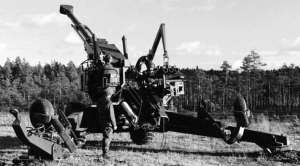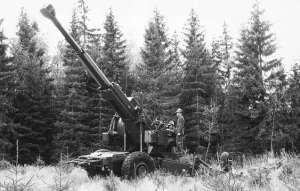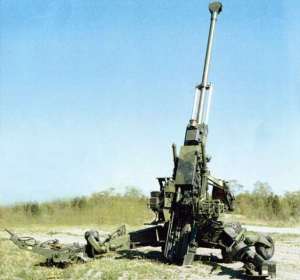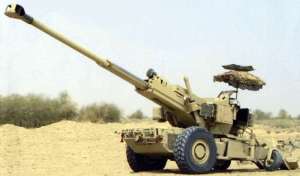| Designation: | FH-77B |
 |
|---|---|---|
| Manufacturer: | Bofors Defence AB | |
| Product type: | Weapons & Weapon Systems | |
| Name: | Towed howitzer |
The now BAE Systems Bofors 155 mm FH-77B (now frequently referred to just as the FH-77) was originally developed as an export model of the FH-77A.
The main change was the ability to fire NATO standard ammunition, other improvements being made to its general handling, cross-country mobility and the introduction of a mechanised ammunition handling system.
Following an FH-77B order from Nigeria, the largest export order in Swedish history came when India placed an initial order for 410 FH-77B weapons and equipment. AB Bofors (today BAE Systems Bofors) acted not only as manufacturer but as the major supply contractor for items such as Saab-Scania trucks, Barracuda camouflage netting, Marconi Command and Control Systems Quickfire fire-control systems, Fairey Australia muzzle velocity radars, BEAB sighting equipment and surveying equipment from Wild of Switzerland and navigation equipment from the then Ferranti UK. First production FH-77Bs for India left the Bofors factory in August 1986.
The first Indian order for the FH-77B was for a total of 410 weapons with final systems delivered in 1990. The company delivered FH-77Bs to India in complete batteries to enable Indian artillery units to become fully operational as complete units.
The ammunition included smoke, illuminating (Bofors) and new High-Explosive Extended-Range (HEER) projectiles for which India was the first customer. There were two versions of the HEER supplied, one with boat tail and the other with base bleed.
When the original order was placed by India, it was envisaged that the total Indian requirement would consist of some 1,500 weapons.
The second batch of FH-77Bs would have been assembled in India from components supplied by the company, with the third batch being made under licence in India. For a number of reasons, India did not place any further orders for the FH-77B.
In July 1999, the company announced that it had received a small but important contract from India for spare parts for the 410 155 mm FH-77B field howitzers used by the Indian Army. This was the first order placed by India with the company since 1989.
The order covered the continuance of spare parts within the framework of the original FH-77B contract placed in 1986.
A second contract was placed in India with the company in September 1999 for further spare parts worth a total of SKr190 million.
In March 1990, the company announced that the Swedish Materiel Defence Administration had placed a USD162 million contract with Bofors for the supply of 48 FH-77B artillery systems, spares, software, ammunition and associated charges. The actual quantity was subsequently increased and a total of 51 are currently in service in Sweden.
The Swedish Army FH-77Bs are similar to those produced for India but with some modifications to enable them to be operated at lower temperatures.
The Nigerian FH-77Bs and the original Indian FH-77Bs had a parallel pepperpot muzzle brake but, following trials with the more recent ammunition types, including HEER used with charge 9, a new and more efficient muzzle brake of the double-baffle type was developed. This was fitted to late production FH-77Bs and has now been retrofitted to earlier weapons.
Ammunition in the Swedish Army order included the locally developed HEER projectile, developed to meet the requirements of the Indian Army which, when used with charge 9, has a range of 30,000 m. HEER-BB (High Explosive Extended-Range - Base Bleed) was included in the order and the FH-77B could also use ammunition already stockpiled by the Swedish Army.
The FH-77B differs from the earlier FH-77A in three main areas; a slightly longer barrel, the introduction of a breech screw mechanism using bag charges, and a new hydraulic loading system. The FH-77B can be towed at speeds of up to 70 km/h, normally by the Saab-Scania SBAT 111S (6 × 6). For cross-country travel the driver of the tractor vehicle can remotely engage the gun roadwheels by starting the gun hydraulic motor making an 8 × 8 combination. Maximum speed in this configuration is 7 km/h and when this speed is exceeded the gun wheels are disengaged.
Steering is by regulating the drive to the independent roadwheels of the gun. The same hydraulic motor can also be used for several other functions. To get the gun into action the driver on the gun uses the hydraulic power to raise the gun castor wheels on the trail to disengage from the tractor towbar. In the self-propelled mode the trails could be locked together or split. The gun driver then reverses the gun to dig the trail spades into the ground. For making changes of fire direction the same process can be repeated. Using this system the driver on the gun can make rapid fire direction changes, get the gun in and out of action and move the gun from one firing location to another alone.
The ammunition loading system uses a hydraulic crane driven from the hydraulic system. The crane grab is designed to lift any 155 mm projectile in groups of three at a time, offered to the grab either horizontally or vertically and almost any projectile length can be handled, including the longer enhanced-range projectiles. From the crane the projectiles are loaded onto a loading table and are then guided onto the loading tray, while another loader places the propellant charge onto a separate loading trough/rammer. In two operations the projectile loading tray is swung over to line up with the chamber and the charge tray swings over behind it. The projectile is then hydraulically rammed forward into the chamber with the charge pushed right forward behind the projectile. Once the projectile is seated in the driving bands the loading trough/rammer is withdrawn until the charge is stripped from the tray by a retaining catch. The rammer mechanism is fully withdrawn, the breech screw is closed and a primer cartridge automatically loaded into the primer seat from a magazine holding eight tubes. Using this system, projectiles and charges can be loaded into the gun at angles of elevation of up to +70°. The rate of fire, with three people on the gun, can be three rounds in 12 seconds. The subsequent rate of fire is governed only by the ammunition supply. An added bonus of the hydraulic ramming is that uniform ramming reduces the resultant projectile dispersion.
The full crew of the FH-77B is six: the gun commander, a layer and four loaders. One loader operates the mechanism for loading the projectiles from the loading table to the loading tray, one prepares the projectiles by inserting the fuzes, setting them and loading the projectiles in groups of three into the loading crane, one places the charges onto the loading tray and another loader operates the ammunition crane. If necessary, only the layer, crane operator and projectile loader combined, and a charge loader can operate the gun in action. There is a special internal communication system built into each gun, separate from the usual fire-control communication systems, with a 10 m range based on an induction loop with receivers built into the crew's ear protectors. Gunlaying is fully hydraulic. Two levers, one on the right for elevation and depression and one on the left for traverse allow barrel movement. Several types of sight may be fitted but the usual model fitted is the electronic BEAB BAAB RIA. The layer sits high on the left of the breech with a protective open cage over the seat and sight (the loading crane is on the right of the breech). A ×4 telescope sight is fitted for direct fire. The BAAB NK24 night sight fitted in front of the ordinary telescopic sight permits direct fire under night conditions. As the FH-77B depends on hydraulic power for many of its systems, an electric motor for all operations using an internal or external power supply or two hydraulic hand pumps are provided in case the main system fails. One, situated just forward of the layer's position and in the power compartment itself, can provide manual hydraulic power for traverse, elevation and ramming. The other pump is on the other side of the gun and provides manual hydraulic power for operating the support wheels.
Unlike the FH-77A the ammunition system of the FH-77B is based on a bagged charge system which enables a wide range of 155 mm ammunition to be fired, including the following main types of projectile: BAE Systems Bofors HE M/77 B, which is a high-capacity shell weighing 42.6 kg and containing 8 kg of TNT or Composition B. This has a maximum range of 24,000 m when fired from the FH-77B howitzer. The round is fully compatible with all Western-manufactured guns and internationally adopted fuzes.
HE M107, the standard NATO 155 mm howitzer projectile weighing 42.91 kg. It can be fired to a range of approximately 19,000 m.
Development of a base bleed round designated HEER (High-Explosive Extended-Range) has been completed by BAE Systems Bofors. HEER is compatible with all Western-manufactured 155 mm guns and international fuzes. Maximum range is 30,000 m and the weight is the same as conventional 155 mm rounds. This involves less stress on the barrel than firing other types of projectiles such as base bleed with a greater weight. Production is also made easier by omitting ERFB nubs.
Other rounds available are different types of smoke (including infra-red smoke) and the MIRA illuminating round in two versions, with maximum ranges of 17,000 m and 24,000 m respectively. For both, the time of illumination is 60 seconds, descending velocity 4 m/s and the mean illuminating intensity is 2.2 Mcd.
Standard NATO and other propellant charges can be used with the FH-77B but the company is now producing its own charges especially for the FH-77B. Charges available include M3 which provides a maximum muzzle velocity of 375 m/s to give a range of 10,300 m and M4 which provides a maximum muzzle velocity of 563 m/s to give a range of 15,500 m.
Charges include the Charge 8 which is roughly equivalent to M119 but gives more favourable pressure and burning properties at extreme temperatures. Charge 8 provides a muzzle velocity of 685 m/s to give a range of 19,000 m. Charge 9 is a new development to provide a muzzle velocity of 827 m/s and a range with standard projectiles of 24,000 m and with base bleed projectiles of 30,000 m.
The FH-77B can also fire the 155 mm BONUS top-attack artillery projectile developed to meet the operational requirements of the French and Swedish armies by the now BAE Systems Bofors of Sweden and Nexter of France. First production Bonus projectiles were handed over to France and Sweden in mid-2002.
The FH-77A was developed to meet the requirements of the Swedish Army and a total of 200 were built between 1978 and 1984. All of these have now been phased out of service and scrapped. Further development of the FH-77A resulted in the FH-77B.
The 51 155 mm FH-77Bs delivered to the Swedish Army by late 1992 were fitted with the Honeywell MAPS (Modular Azimuth Position System) land navigation system. The Honeywell MAPS system was fitted to the small number of 155 mm Bandkanon 1A self-propelled artillery systems used by the Swedish Army. These have now been withdrawn from service and scrapped.
The now BAE Systems Bofors built 200 of the earlier FH-77 towed systems for the Swedish Army of which 100 are in reserve and 100 have been sold.
A total of 51 of the improved FH-77B were built and these are now the only front line artillery systems deployed by Sweden.
These are expected to be rebuilt in the 6 × 6 FH-77BD L52 self-propelled configuration.
It will consist of the latest generation Volvo 6 × 6 all terrain chassis with a 155 mm/52 calibre ordnance and upper part, for example elevating mass and saddle, of the towed FH-77B mounted on the rear.
This is also referred to as Archer and details are given in a separate entry.
The now BAE Systems Bofors has upgraded two examples of the FH-77B 39 calibre with a 155 mm/52 calibre ordnance and this is designated the FH-77 B05 L52. They were successfully demonstrated in India in 2002, 2003, 2004 and 2006. As of early 2008 no production contracts had been awarded by India for any 155 mm artillery systems.
The FH-77 B05 L52 enables a range of 40 plus km to be achieved with standard base bleed projectiles. It is fitted with an integrated navigation, positioning and aligning system and onboard ballistic computation.
The new gun computer has a man-machine interface similar to standard commercial PCs, which facilitates the training and operation of the computer, according to the company.
Many procedures are automatic including indirect laying and execution of MRSI firings. According to the now BAE Systems Bofors this automation improves speed, accuracy and safety when firing. In addition, the operator will also have access to manuals stored in the computer.
The onboard gun computer and navigation system give the system an autonomous capability. It is also fitted with a new turbocharged diesel engine. The communications equipment installed allow it to communicate with not only with other weapons but also other batteries up to a range of 5 km.
It can fire all standard types of 155 mm artillery projectiles using modular- or bag-type charges. It also has a direct-fire capability and a MRSI with up to five projectiles hitting the target within three seconds from one weapon. It has a direct-fired range out to 2,000 m.
Many of the components of the latest FH-77 B05 L52 are identical to the existing FH-77B, which allows existing customers to upgrade their weapons with a 155 mm/52 calibre barrel.
|
||||||||||||||||||||||||||||||
 |
 |
 |
 |
